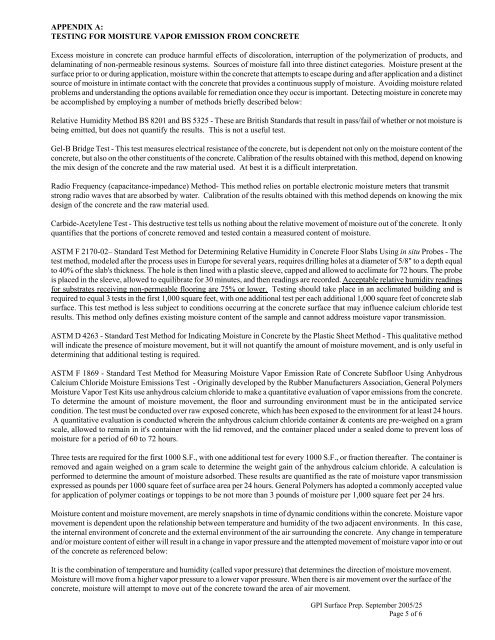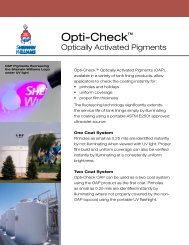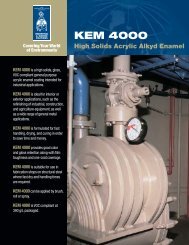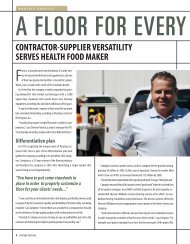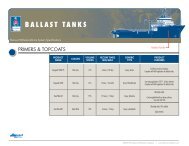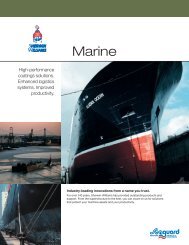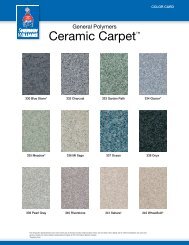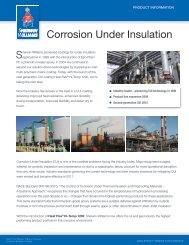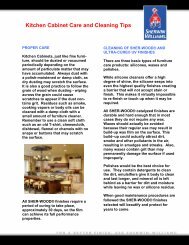Testing for moisture vapor emission form concrete (pdf) - Protective ...
Testing for moisture vapor emission form concrete (pdf) - Protective ...
Testing for moisture vapor emission form concrete (pdf) - Protective ...
Create successful ePaper yourself
Turn your PDF publications into a flip-book with our unique Google optimized e-Paper software.
APPENDIX A:TESTING FOR MOISTURE VAPOR EMISSION FROM CONCRETEExcess <strong>moisture</strong> in <strong>concrete</strong> can produce harmful effects of discoloration, interruption of the polymerization of products, anddelaminating of non-permeable resinous systems. Sources of <strong>moisture</strong> fall into three distinct categories. Moisture present at thesurface prior to or during application, <strong>moisture</strong> within the <strong>concrete</strong> that attempts to escape during and after application and a distinctsource of <strong>moisture</strong> in intimate contact with the <strong>concrete</strong> that provides a continuous supply of <strong>moisture</strong>. Avoiding <strong>moisture</strong> relatedproblems and understanding the options available <strong>for</strong> remediation once they occur is important. Detecting <strong>moisture</strong> in <strong>concrete</strong> maybe accomplished by employing a number of methods briefly described below:Relative Humidity Method BS 8201 and BS 5325 - These are British Standards that result in pass/fail of whether or not <strong>moisture</strong> isbeing emitted, but does not quantify the results. This is not a useful test.Gel-B Bridge Test - This test measures electrical resistance of the <strong>concrete</strong>, but is dependent not only on the <strong>moisture</strong> content of the<strong>concrete</strong>, but also on the other constituents of the <strong>concrete</strong>. Calibration of the results obtained with this method, depend on knowingthe mix design of the <strong>concrete</strong> and the raw material used. At best it is a difficult interpretation.Radio Frequency (capacitance-impedance) Method- This method relies on portable electronic <strong>moisture</strong> meters that transmitstrong radio waves that are absorbed by water. Calibration of the results obtained with this method depends on knowing the mixdesign of the <strong>concrete</strong> and the raw material used.Carbide-Acetylene Test - This destructive test tells us nothing about the relative movement of <strong>moisture</strong> out of the <strong>concrete</strong>. It onlyquantifies that the portions of <strong>concrete</strong> removed and tested contain a measured content of <strong>moisture</strong>.ASTM F 2170-02– Standard Test Method <strong>for</strong> Determining Relative Humidity in Concrete Floor Slabs Using in situ Probes - Thetest method, modeled after the process uses in Europe <strong>for</strong> several years, requires drilling holes at a diameter of 5/8" to a depth equalto 40% of the slab's thickness. The hole is then lined with a plastic sleeve, capped and allowed to acclimate <strong>for</strong> 72 hours. The probeis placed in the sleeve, allowed to equilibrate <strong>for</strong> 30 minutes, and then readings are recorded. Acceptable relative humidity readings<strong>for</strong> substrates receiving non-permeable flooring are 75% or lower. <strong>Testing</strong> should take place in an acclimated building and isrequired to equal 3 tests in the first 1,000 square feet, with one additional test per each additional 1,000 square feet of <strong>concrete</strong> slabsurface. This test method is less subject to conditions occurring at the <strong>concrete</strong> surface that may influence calcium chloride testresults. This method only defines existing <strong>moisture</strong> content of the sample and cannot address <strong>moisture</strong> <strong>vapor</strong> transmission.ASTM D 4263 - Standard Test Method <strong>for</strong> Indicating Moisture in Concrete by the Plastic Sheet Method - This qualitative methodwill indicate the presence of <strong>moisture</strong> movement, but it will not quantify the amount of <strong>moisture</strong> movement, and is only useful indetermining that additional testing is required.ASTM F 1869 - Standard Test Method <strong>for</strong> Measuring Moisture Vapor Emission Rate of Concrete Subfloor Using AnhydrousCalcium Chloride Moisture Emissions Test - Originally developed by the Rubber Manufacturers Association, General PolymersMoisture Vapor Test Kits use anhydrous calcium chloride to make a quantitative evaluation of <strong>vapor</strong> <strong>emission</strong>s from the <strong>concrete</strong>.To determine the amount of <strong>moisture</strong> movement, the floor and surrounding environment must be in the anticipated servicecondition. The test must be conducted over raw exposed <strong>concrete</strong>, which has been exposed to the environment <strong>for</strong> at least 24 hours.A quantitative evaluation is conducted wherein the anhydrous calcium chloride container & contents are pre-weighed on a gramscale, allowed to remain in it's container with the lid removed, and the container placed under a sealed dome to prevent loss of<strong>moisture</strong> <strong>for</strong> a period of 60 to 72 hours.Three tests are required <strong>for</strong> the first 1000 S.F., with one additional test <strong>for</strong> every 1000 S.F., or fraction thereafter. The container isremoved and again weighed on a gram scale to determine the weight gain of the anhydrous calcium chloride. A calculation isper<strong>for</strong>med to determine the amount of <strong>moisture</strong> adsorbed. These results are quantified as the rate of <strong>moisture</strong> <strong>vapor</strong> transmissionexpressed as pounds per 1000 square feet of surface area per 24 hours. General Polymers has adopted a commonly accepted value<strong>for</strong> application of polymer coatings or toppings to be not more than 3 pounds of <strong>moisture</strong> per 1,000 square feet per 24 hrs.Moisture content and <strong>moisture</strong> movement, are merely snapshots in time of dynamic conditions within the <strong>concrete</strong>. Moisture <strong>vapor</strong>movement is dependent upon the relationship between temperature and humidity of the two adjacent environments. In this case,the internal environment of <strong>concrete</strong> and the external environment of the air surrounding the <strong>concrete</strong>. Any change in temperatureand/or <strong>moisture</strong> content of either will result in a change in <strong>vapor</strong> pressure and the attempted movement of <strong>moisture</strong> <strong>vapor</strong> into or outof the <strong>concrete</strong> as referenced below:It is the combination of temperature and humidity (called <strong>vapor</strong> pressure) that determines the direction of <strong>moisture</strong> movement.Moisture will move from a higher <strong>vapor</strong> pressure to a lower <strong>vapor</strong> pressure. When there is air movement over the surface of the<strong>concrete</strong>, <strong>moisture</strong> will attempt to move out of the <strong>concrete</strong> toward the area of air movement.GPI Surface Prep. September 2005/25Page 5 of 6
For these reasons, it is important to measure the temperature and relative humidity during the test period. The MoistureVapor Test Kit values will not be useful in predicting possible problem areas unless the tests are conducted in the environmentin which the structure will be used. The air temperature and humidity around the <strong>concrete</strong> during the test should be thesame air temperature and humidity that will be in place during the useful life of the structure. Contact the Technical ServiceDepartment immediately if there are any questions concerning the use of the test kits or interpretation of the results.To successfully and predictably reduce <strong>moisture</strong> <strong>vapor</strong> <strong>emission</strong> rates apply one of the following remediation systems:‣ General Polymers P-105 Penetrator with General Polymers Epoxy Water Emulsion Primer/Sealer (3477);‣ General Polymers P-105 Penetrator in combination with General Polymers Recover #9000 System;‣ FasTop MVT; or‣ AquArmor MVT.Consultation with the Technical Service Department <strong>for</strong> specific recommendations and utilized in accordance with applicationinstructions. For slabs with potential <strong>moisture</strong> issues, utilizing systems that are designed to accommodate <strong>moisture</strong> movementfrom the slab such as FasTop and AquArmor Systems may be the most cost effective alternative. Whenever, <strong>moisture</strong> issuespresent themselves on a project document the conditions, in<strong>for</strong>m the owner representative and consult with General Polymerstechnical service personnel.Consult the technical paper, "Prevention of Moisture Related Disbondment of Non-Permeable FlooringSystems", <strong>for</strong> more details and potential solutions if a problem is detected. For copies of this and other technicalarticles, please visit our web site at www.generalpolymers.com or contact your local sales representative.Note: The industry standard <strong>for</strong> curing <strong>concrete</strong> is 28 days. This is usually sufficient to allow excess <strong>moisture</strong> to leavea <strong>concrete</strong> slab. To minimize <strong>moisture</strong> related disbondment, new <strong>concrete</strong> should be allowed to cure 28 days be<strong>for</strong>einstallation of General Polymers non-permeable resinous flooring systems. If any doubts exist concerning <strong>moisture</strong> in the slab,Calcium Chloride and/or Humidity tests should be run to document the presence of <strong>moisture</strong>.DEW POINT CALCULATION CHART (FAHRENHEIT)%RelativeHumidityAMBIENT AIR TEMPERATURE ºF20 30 40 50 60 70 80 90 100 110 12090 18 28 37 47 57 67 77 87 97 107 11785 17 26 36 45 55 65 75 84 95 104 11380 16 25 34 44 54 63 73 82 93 102 11075 15 24 33 42 52 62 71 80 91 100 10870 13 22 31 40 50 60 68 78 88 96 10565 12 20 29 38 47 57 66 76 85 93 10360 11 19 27 36 45 55 64 73 83 92 10155 9 17 25 34 43 53 61 70 80 89 9850 6 15 23 31 40 50 59 67 77 86 9445 4 13 21 29 37 47 56 64 73 82 9140 1 11 18 26 35 43 52 61 69 78 8735 -2 8 16 23 31 40 48 57 65 74 8330 -6 4 13 20 28 36 44 52 61 69 77www.generalpolymers.com© The Sherwin-Williams Company All Rights Reserved September 2005Cincinnati, OH(800) 543-7694GPI Surface Prep. September 2005/25Page 6 of 6


